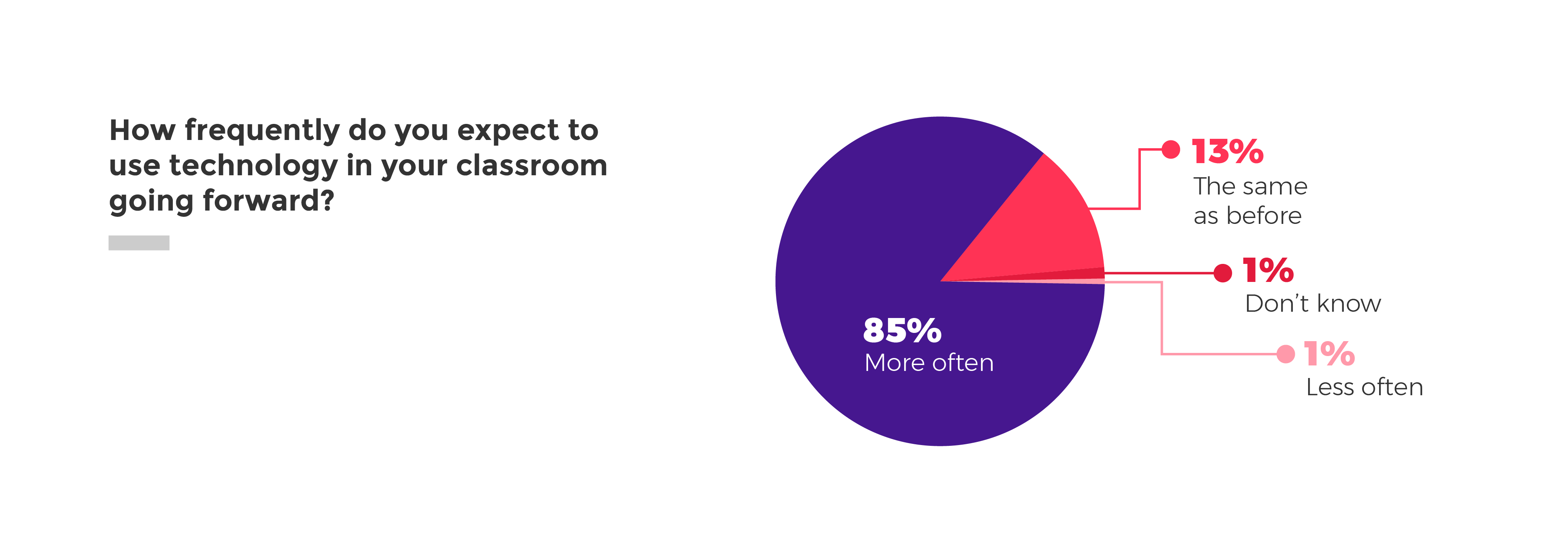With COVID-19 closing schools around the globe for months before summer, this last school year was truly one like no other. Now, as teachers and school leaders are faced with uncertainty as they prepare for back-to-school, it’s the right time to reflect on the distance learning and virtual teaching experience and look ahead to what’s next for schools in the coming year.
In July, Kahoot! surveyed 1,200+ teachers and school admins globally, with teachers from all grade levels as well as colleges and universities. The Kahoot! EDU survey, sent as a Kahoot! challenge, invited educators to share their thoughts on virtual learning, what they learned last year, and trends they expected to see when they headed back to school. The results provided important insights into how education is adapting to the challenges of the COVID-19 pandemic. Below are the key findings from the survey:

Blended learning is on the horizon for most schools in the upcoming year
Many educators have highlighted the challenge of balancing health and safety with meeting their students’ and families’ needs, particularly as some students lack access to the internet or a computer at home. As schools work to keep their students and staff safe during the ongoing COVID-19 pandemic, many school administrators are planning for a blended learning system in the upcoming academic year.
Nearly 7 in 10 teachers we surveyed expect to see a mix of distance and in-classroom learning in the upcoming school year. Only 16% of educators believe their school will operate solely through distance learning, and 7% expect a year of regular classroom-based learning.

U.S. schools lead the blended learning trend
Teachers in the U.S. expect to see blended learning in their schools more than in any other region, with nearly 3 in 4 surveyed teachers saying they expect a mix of distance and in-classroom learning for the 2020-2021 year. Europe follows with 63% expecting blended learning, and Asia is slightly more distributed, with 48% anticipating blended learning and 36% expecting all distance learning.
4 out of 10 respondents globally also named blended learning as the main trend for classrooms they predict for the next few years, followed by nearly 1 in 4 who named diversity and inclusion training.

Teachers’ biggest challenge was lack of social interaction and engagement with students
For teachers, the toughest part of the shift to distance learning was the lack of social contact with their students, as well as seeing their students struggle with engagement, according to 64% of those surveyed.

Although nearly 3 in 10 teachers we surveyed said the most challenging part of teaching virtually was getting used to the different technology and tools, 85% of surveyed educators expect to use technology more frequently in their classrooms in the future, and 13% plan on maintaining their current level of technology use. Only 0.4% expect to use technology less frequently.

Teachers split on feeling safe to return to the classroom
With still so much uncertainty about what the upcoming year will bring, both at school and in the wider world, teachers are fairly divided on how safe they feel in returning to the classroom for the 2020-2021 academic year.
A slight majority (52%) feel either very safe or somewhat safe, while 47% feel somewhat or very unsafe. Interestingly, respondents in Europe report feeling the safest, with 58% of surveyed teachers in Europe feeling very or somewhat safe, followed by 54% of respondents in Asia. Teachers in America feel the least safe globally, with 49% reporting feeling very or somewhat safe to return to the classroom this fall.

Teachers see benefits in virtual learning
While school closures have been challenging for most teachers and students, a large majority of educators also see benefits that both they and their students have experienced from this period of virtual learning.

More than 3 out of 4 responding teachers believe that their students took away something positive from learning virtually during school closures, and 9 out of 10 agreed or strongly agreed that they as teachers have learned something positive from their experience with virtual learning.

Educators report improved teaching in distance learning
Nearly 9 in 10 surveyed educators reported that at least one element of their teaching improved because of distance learning. 36% said they got better at meeting students’ varied needs and learning styles, while 30% said their communication with parents and students improved, and 22% reported feeling higher motivation to teach while teaching virtually.

Supporting diversity and inclusion in the classroom
As well as developing teaching skills generally, almost as many educators surveyed (85%) also reported changing their virtual/blended teaching to support diversity and inclusion. Over 4 in 10 said they tailored instruction to meet students’ individual learning needs. 23% said they facilitated class discussions about diversity & inclusion, and 20% reported adding diverse voices and narratives to the curriculum.

Keeping learning awesome in unprecedented times
With the sudden transition to distance learning, Kahoot! has become a must-have learning tool in many teachers’ virtual classrooms. Teachers such as Ashley Kollar, are taking advantage of its user friendly interface and game dynamics to keep students engaged through self-paced challenges, reinforce content, and even make assessments fun. Today, Kahoot! is used by 50% of K-12 teachers in the U.S., and over 6 million teachers globally have used Kahoot! in the last year.
These findings are based on a global survey of 1,207 educators registered for the Kahoot! EDU Summit in June 2020. Registrants of the Kahoot! EDU Summit were sent a post-event survey, in the form of a Kahoot! challenge. If you are an educator and would like to take the same survey, you can take it as a Kahoot! challenge. You can also see the survey findings in infographic format here.





